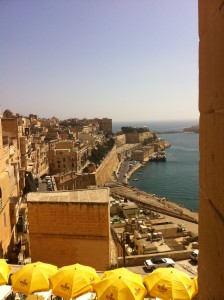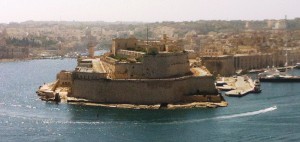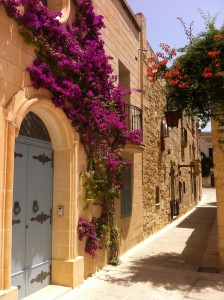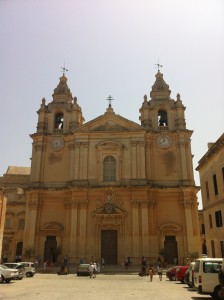Part One:
 Malta: island of knights and castles, Italian painters and British phone boxes, bays and boats and beaches, cliffs and torrijiet (Maltese towers), flea markets, fine lace and fenkata. It was a whirlwind tour in the heat of the summer. As we raced around the island, packed to the gunnels in a pocket-sized car, we attempted to cover every square inch in three days. I think we just about did it.
Malta: island of knights and castles, Italian painters and British phone boxes, bays and boats and beaches, cliffs and torrijiet (Maltese towers), flea markets, fine lace and fenkata. It was a whirlwind tour in the heat of the summer. As we raced around the island, packed to the gunnels in a pocket-sized car, we attempted to cover every square inch in three days. I think we just about did it.
Most recently a British colony – Queen Elizabeth and Prince Philip spent the early years of their marriage posted here with the Royal Navy – Malta has also belonged, amongst others, to the Phoenicians, the Romans, the Arabs and the French. In fact, Malta has only been ruled by the Maltese since 1964. Lonely Planet calls it ‘a microcosm of the Mediterranean’ with its eclectic mix of North African, Italian and Arabic influences.
This rocky outcrop in the middle of the Mediterranean actually consists of three islands: Malta, Gozo and Comino. Parched and yellow in summer, with the occasional splash of green vineyard and dry, honey-coloured limestone walls, these three jewels are set in sapphire blue seas. The ferry from Pozzallo is the most picturesque way to arrive. The huge catamaran slips quietly into the Grand Harbour of the Port of Valletta, which is lined with cruisers, tankers, sailing boats and dinghies, and overlooked by nineteen stone warehouses, two hundred and fifty years old, stretching along the Quay Wall, where the Knights of St John and European merchants once unloaded their ships.
 In 1530 Malta became the official home of the Knights of the Order of St. John of Jerusalem, better known as the Knights of Malta, a renowned Christian security force of the Middle Ages. In the decades that followed, these wealthy knights turned Valletta into an architectural showcase of palaces, gardens, and churches, many of which remain today as major tourist attractions. Every summer the population of these tiny Mediterranean islands triples in size due to the huge influx of tourists and pensioners (who retire here from northern Europe for the joys of a warm, dry climate), the largest boost to the local economy.
In 1530 Malta became the official home of the Knights of the Order of St. John of Jerusalem, better known as the Knights of Malta, a renowned Christian security force of the Middle Ages. In the decades that followed, these wealthy knights turned Valletta into an architectural showcase of palaces, gardens, and churches, many of which remain today as major tourist attractions. Every summer the population of these tiny Mediterranean islands triples in size due to the huge influx of tourists and pensioners (who retire here from northern Europe for the joys of a warm, dry climate), the largest boost to the local economy.
The island of Malta is about 17 miles long and 9 miles wide. Don’t let the size fool you, the winding roads and cluttered town streets can still make any trip seem a lot further than it looks on the map. The blessing is, though, that whenever the heat and crowds being to overwhelm, you are never too far from the sea in which to cool off.
 So what did we manage to see in three days? Where shall I start? Mdina, Città Vecchia, is the original capital of Malta, a beautiful medieval town, walled and moated, situated on a strategic hill in the middle of the island. Mdina is a town of quiet, quaint, cobbled streets, with a resident population of just over three hundred. There is an elegant Cathedral with its canons facing into the square, and two clocks set at different times to confuse the devil, who is apparently not very bright, and cannot tell the difference between day and night. Just inside the main gates are the Mdina Dungeons, which house a gruesomely enticing display of mediaeval instruments of torture and methods of execution. Our teenagers loved all the blood and gore, and it didn’t seem to turn their stomachs too badly, as they later filled themselves up on cakes and milk shakes, at a busy café on the ramparts, while we gazed at the wonderful view across the island.
So what did we manage to see in three days? Where shall I start? Mdina, Città Vecchia, is the original capital of Malta, a beautiful medieval town, walled and moated, situated on a strategic hill in the middle of the island. Mdina is a town of quiet, quaint, cobbled streets, with a resident population of just over three hundred. There is an elegant Cathedral with its canons facing into the square, and two clocks set at different times to confuse the devil, who is apparently not very bright, and cannot tell the difference between day and night. Just inside the main gates are the Mdina Dungeons, which house a gruesomely enticing display of mediaeval instruments of torture and methods of execution. Our teenagers loved all the blood and gore, and it didn’t seem to turn their stomachs too badly, as they later filled themselves up on cakes and milk shakes, at a busy café on the ramparts, while we gazed at the wonderful view across the island.
The ‘new’ sixteenth century capital, Valletta is a beautiful baroque town above the port full of souvenirs left behind by the Knights of Malta. Some have been altered or demolished by the British, and even more were destroyed in Nazi bombing raids, yet the city that remains is stunning, and infinitely appealing, even in 35’C. Modern structures have been tastefully added to compliment the older buildings, and the city exudes refined elegance and reams of character.
 We began our walking tour of Valletta, a UNESCO World Heritage site, at the Upper Barrakka gardens, where a colonnaded terrace frames a beautiful picture of the Grand Harbour. We then sauntered down Merchant’s Street to the flea market, which sells all sort of cheap clothing and souvenirs, such as samples of the local lace. We discovered the covered market place. Is-Suq is the only one of its kind in Malta, with its beautiful British wrought iron but these days looking a little sad and neglected. Apparently there has been talk of renovation or rebirth as a museum, but so far it has sat undisturbed, tucked behind a plethora of overflowing stalls.
We began our walking tour of Valletta, a UNESCO World Heritage site, at the Upper Barrakka gardens, where a colonnaded terrace frames a beautiful picture of the Grand Harbour. We then sauntered down Merchant’s Street to the flea market, which sells all sort of cheap clothing and souvenirs, such as samples of the local lace. We discovered the covered market place. Is-Suq is the only one of its kind in Malta, with its beautiful British wrought iron but these days looking a little sad and neglected. Apparently there has been talk of renovation or rebirth as a museum, but so far it has sat undisturbed, tucked behind a plethora of overflowing stalls.
We meandered on to St John’s Co-Cathedral, built by the Knights of Malta between 1573-8. When Napoleon invaded Malta in 1798 the French took away everything of value that was not fixed in stone, except for the golden gates into this highly ornate and intricately carved Cathedral, which were painted black by the locals and consequently overlooked during the pillaging of the city. St. John’s now houses an outstanding collection of Baroque art, including two masterpieces by Caravaggio, The Beheading of St John the Baptist and St Jerome Writing (stolen on New Year’s Eve in 1984, but subsequently recovered), which hang in the oratory. Unfortunately the immense crush of mid-summer tour groups drove me rapidly, and dizzily, into a quiet, walled piazza beside the Cathedral, apparently a lovely spot for summer concerts.
Once my head stopped spinning, we cut our losses on museums and queues and strolled across town to St George’s Square and the Piazza Regina, wonderful open spaces with an eye-catching architectural blend of ancient and modern. Pavement cafés and designer shops abound, and a new dancing fountain intermittently shoots jets of water into the air in the middle of St. George’s Square, entertaining adults and children alike, as they dodge and weave through the spray, the perfect panacea to a hot day.
As the shadows begin to crawl across the city, we wander along Republic Street and back past the controversial construction site for the new city gate, parliament building and an open-air performance space to replace the Opera House bombed by the Luftwaffe at the end of World War II, designed by world famous Italian architect Renzo Piano.
Malta is a tiny island nation steeped in history, soaking in azure seas, and dazzling the eyes with luscious views, not to mention dazzling the taste buds with luscious food. But more of that later…
